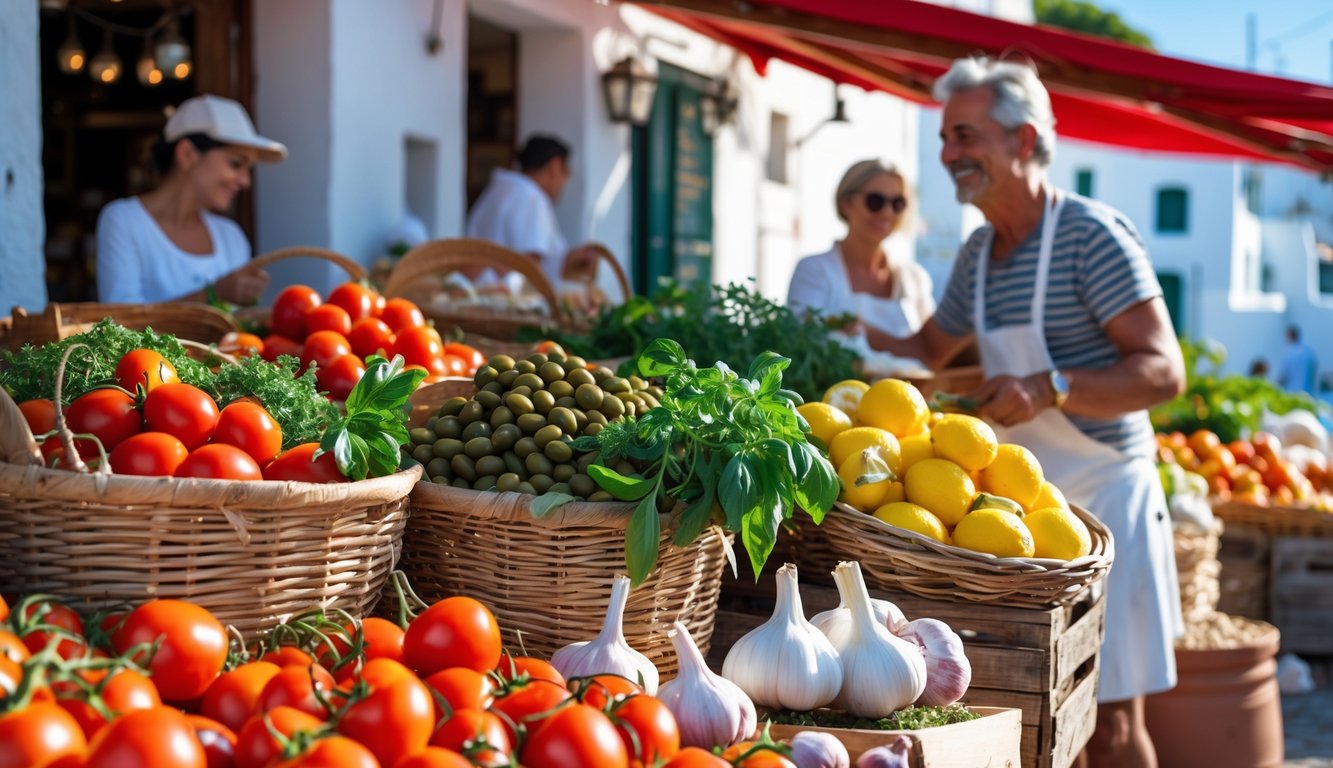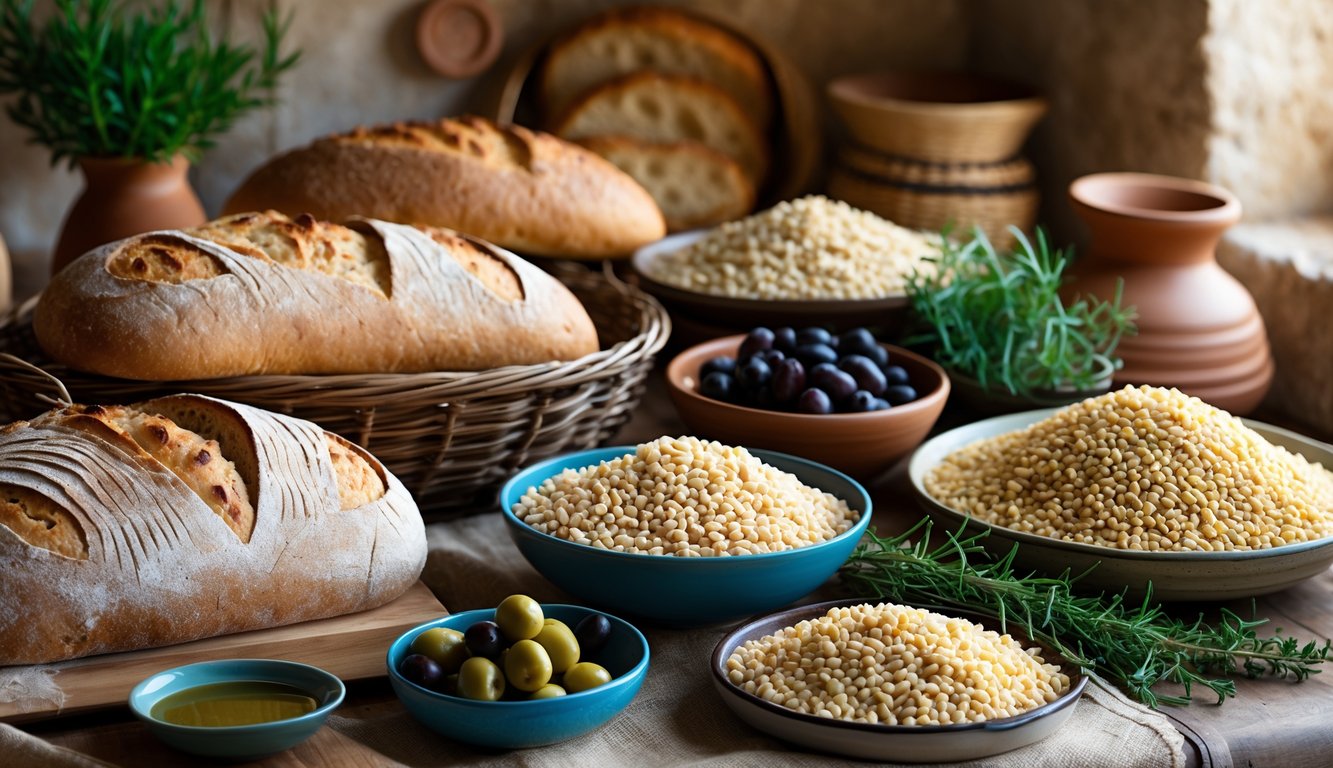
Grains and Breads: The Foundation of Every Meal

Think you know bread? Try chasing down a bakery at 6 a.m. in Thessaloniki just for the first wobbly heel off a sourdough round. Nobody talks about stale crusts as flavor bombs, but they should. The wild thing about Mediterranean food is how locals just rip up bread and toss it on the plate—napkin, shovel, half the meal. Calories? Who’s counting? Every table’s a carb party, with chewy hunks and grains scattered everywhere. Nutritionists would probably lose their minds trying to plan a menu here.
Whole Grains and Traditional Dishes
I’m embarrassed to admit how long it took me to realize most meals—especially in Greece and southern Italy—aren’t just pasta and rice. Yeah, about 40% of calories come from carbs, but it’s usually dark, seeded bread or grains mixed into stews and salads (the Mediterranean Pyramid says so, not that anyone actually reads it). No one’s hiding white bread under a fake-healthy label. Traditional cooks just drag in barley, bulgur, farro—barely dressed except with olive oil or lemon. Nutritionists keep yelling about whole grain bread or dense country loaves without sugar. Maybe they’re right, I don’t know.
Throwing grains into spinach rice or chickpea salads isn’t a science, it’s just what happens. You end up with fiber, B vitamins, and slow-burning energy that does its job. No fireworks, no sugar crash. I still remember a chef yelling “bread as fork!” while scooping up vegetables with last night’s sourdough. Why use a fork? Less to wash.
Unique Mediterranean Breads
Shouldn’t all bread taste the same? Not even close. Sometimes my lunch is literally held together by a slab of rustic bread heavier than my carry-on. Locals argue about the best kind, but good luck convincing anyone to ditch their favorite. Sprouted grain bread with olive oil, pita stuffed with leftover eggplant, pan de higo in Spain, whole-wheat pitas in Israel, jaw-breaking Cretan dakos—pick your fighter.
Nobody’s eating that sweet, fluffy supermarket bread—if they are, they’re hiding it. The best bakers skip sugar, go heavy on fermentation, and the result is dense, chewy, nothing like what you grab at the grocery store in the U.S. Bread isn’t just some neutral backdrop. It’s an active, crumb-dropping, olive oil-sopping presence. Blink and it’s gone.
Local Dishes and Authentic Recipes
Nothing makes me laugh harder than seeing “Mediterranean blend” next to microwaved pizza on a menu. Twelve ingredients, most of them olive oil or some random green, and suddenly it’s a “culinary journey”? Meanwhile, the real stuff never gets Instagrammed—actual Mediterranean dishes are on tiny handwritten boards, recipes changing with every family’s mood.
Hidden Gems: Less-Known Local Favorites
Let’s talk “hidden gems.” Who’s out there eating black-eyed peas with fresh dill, olive oil, orange slices, and calling it a weekday lunch? But in Crete or random Athens diners, that’s exactly what you get—usually from a grandmother who thinks modern recipes are a crime. Check a real table and you’ll see unpronounceable stews, bowls of freekeh topped with burnt bits from last week’s roast, maybe a tart pickled anchovy beside yesterday’s bread.
Everyone’s obsessed with hummus, but Moroccan harira or fava bean spread barely gets a mention. Tuscan “Pici alle Briciole”—it’s just pasta, breadcrumbs, garlic, olive oil. It tastes like home because it never makes the tourist menu. Somewhere (I think here), I read that trattoria cooks get offended if you ask about “authentic” pici. Nobody’s following a recipe; they just use whatever’s left in the pantry.
Traditional Recipes You’ll Find at Home
Most traditional recipes I’ve tried at home? Four ingredients, tops. People go on about “superfoods,” but my aunts just toss together tomatoes, chickpeas, and a side of family drama. Chickpeas with tahini and lemon, fava beans in everything, bowls of farro or whatever grain’s on hand—none of it’s fancy, but it’s been around way before quinoa got trendy. Mediterranean guides (like this one) say home cooks just hurl dill and parsley into the pot, barely measuring, usually picking herbs that morning.
Moussaka? Sounds simple, never is. But everyone’s got endless patience for prepping fresh herbs, slow-roasting fish, slicing oranges for bean salads nobody outside the region seems to crave. I know a dietitian who says extra virgin olive oil is only “authentic” if you ignore the label and just trust the oldest person in the room. I believe it. Every family’s got their own wild trick for coaxing flavor out of tired vegetables and tough meat. It’s not neat, it’s not trendy, but that’s where the real secrets live.
Signature Mediterranean Dishes Locals Crave
Tourist food fatigue? Yeah, same. The thing about Mediterranean kitchens—half the “classics” tourists eat aren’t what locals grab after work. Nobody’s craving Instagram moments; it’s about layers of cumin, the crunch of cucumber wedged between slabs of feta, and olive oil stains that ruin your shirt before the cicadas shut up.
Greek Salad and Moussaka
It’s not just cucumbers and tomatoes. Dimitris at his Athens café will fight you over horiatiki—real Greek salad means capers, pungent red onions, thick blocks of sheep’s milk feta, and always, Kalamata olives. Drizzle balsamic? You’re already in trouble. Most supermarket jars taste nothing like the briny rush at a beach taverna. Nobody’s weighing anchovies except me, wishing there were more, and saganaki sometimes hijacks the appetizer but gets ignored the next day.
Moussaka? Don’t get me started. Restaurant versions are greasy, neon-lit, and missing the nutmeg punch. The best ones? Church gatherings, Sunday kitchens, roasted eggplant, lamb, cinnamon, and one aunt who refuses to use dried oregano. Every Greek cook I know will debate béchamel thickness for years, then feed it to the dog if it burns.
Souvlaki, Gyros, and Grilled Meats
I’ve lost count of how many hours I’ve spent at kiosks where souvlaki should never come with mayonnaise (tourist trap alert). Pork, chicken, maybe lamb if you know the right person. Wrapped with fries, spicy mustard, not just tzatziki drowning everything. Sometimes you get a tomato that actually tastes like tomato. Gyros? Rotisserie magic, but wildly inconsistent—especially when they swap pork for mystery meat. Gyro isn’t a brand, it’s a knife skill. Even my butcher warns against frozen “Mr. Potato” slabs in the pita. Greeks crave the smoky charcoal, onion bite, and the rare ham treat, as long as nobody tries to call spanakopita “grilled meat” (which, yes, someone actually did at 2 a.m.).
Spanish Paella, Tortilla Española, Risotto Alla Milanese
Ask anyone in Spain and you’ll get a civil war over traditional paella. Valencia defends rabbit and snails, everyone else adds chorizo, seafood, or—yikes—chicken breast. Locals eat paella at big, noisy tables, always in wide, thin pans, never the oven, and leftovers become breakfast tortillas. Tortilla Española? It’s breakfast, lunch, 3 a.m. hangover cure, thicker than any omelet, sometimes more potato than egg. Spanish grandmothers argue about resting time. Along the coast, anchovies and capers show up, ham gets jammed into everything. Risotto alla Milanese should taste of saffron, but sometimes you get hard rice and wonder if anyone’s using Arborio or just cheating with jasmine. Italians know it’s not just about creaminess; it’s about that tiny bite, and nobody wants it rushed.
Moroccan Classics: Harira and Couscous
First time I tried making harira? Disaster. Tomato, lentil, lamb, chickpea, cinnamon, blah blah, but if you skip the lemon at the end or let the noodles get mushy, every Moroccan friend will roll their eyes so hard you can hear it. And during Ramadan, wow, the real stuff shows up—nothing like the sad, watery soup they serve in “Moroccan” spots outside Marrakech. Spices aren’t even standard; one town’s obsessed with cilantro, another dumps in paprika, and some folks grind fava beans until they’re basically dust. I’m not even sure what’s “classic” anymore.
Couscous—don’t even get me started. The boxed stuff? Forget it. Real couscous takes hours, and every grandmother I’ve ever met claims you have to steam it three times or it’s not food. I honestly think Moroccan food doesn’t get enough hype for how it does veggies—roasted, caramelized onions, raisins that turn into little sugar bombs with saffron. Sometimes there’s cold dolma or sticky baklava hiding on a tea tray, but honestly, harira is way better at cutting the sugar than black coffee ever was. Just saying.



